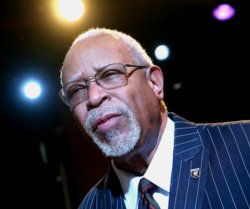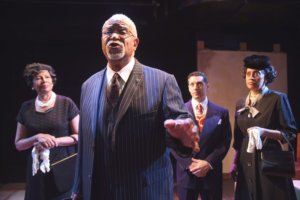
BEATE HEIN BENNETT
| PEACE,
A DANGER TO WELLBEING "Most Dangerous Man in America (W.E.B. Du Bois)"
Amiri Baraka's last play is based on the history of W.E.B Du Bois's
1951 trial brought by the US. Department of Justice against him and
other leaders of the Peace Information Center, an organization that,
like the international peace movements of the time, advocated the
banning of nuclear weapons. It was the time of the Cold War with Russia
and the beginning of the Korean War as well as the height of the Joe
McCarthy hearings in the House Unamerican Activities Committee. The
suspicion by members of the US Congress that the international peace
movements and organizations were compromised by undercover Soviet
intelligence operations made any US citizen suspect who participated
in peace activities. W.E.B. Du Bois, being one of the most prominent
members, along with Paul Robeson, was publicly vilified and put on
trial. Many Jewish and Black intellectuals on the left of the political
spectrum shared that common fate of vilification and legal persecution
at the time. Amiri Baraka clearly admired Du Bois and gives him an unqualified heroic status in the play-- his character can do no wrong but the political powers and social structures around him are full of wrongs. Baraka removes the protagonist from the dramatic element of conflict caused by some character flaw that leads to self-recognition. Instead Baraka’s play maintains a certain Brechtian epic structure that presents the sociopolitical status quo as fundamentally flawed. Woodie King, Jr., a long-time friend of Baraka and champion of his work, directed a cast of eighteen committed actors who managed within these brief vignettes to bring to life a diverse set of historical characters and fictional types, ranging from beauty parlor and barbershop personnel, to "cool street cats," to courtroom personnel, to a Ghanaese welcoming party. The ensemble maintained high energy, at times breaking into dances of complex choreography—50s boogie to African folk—creating a sense of community that enveloped Du Bois, mostly with fond admiration. Art McFarland presented a towering Du Bois whose elegant voice and presence commanded the center of attention. In court, his defense attorney Vito Marcantonio, played by Michael Basile with wily wit, emphasized the contrast in comportment. The white defense attorney and the white prosecutor Maddrix, played with great energy by Nick Plakias, could afford to go at each other in a manner unimaginable for a black man in court. Both actors, supported with sharp humor by Arthur Bartow who played Judge McGuire, brought the court scene to life. A bit of character acting was provided by Stu Richel in the role of Rogge, a befuddled Southern stool pigeon for the prosecution. The scenes between Du Bois and his wife Shirley Graham, played by Petronia Paley with quiet grace equal in strength to Du Bois, gave only a hint of the symbiotic relationship that sustained them through the dangerous trial and implied subsequent ostracism that drove them to leave the US for Ghana. Mr. King's attentive direction gave each actor in their diverse roles moments of poignancy—Siki Fofana as the ingenuous young Richie who inherits Mr. Du Bois's beautiful cane with the admonition to carry the work forward is memorable; Joyce Sylvester plays Sheba, the beautician with a sparkling energy and dances up a storm; Marie-Louise Guinier is the picture of an elegant black lady in the 50s. Robert G. Siverls as Hermann, the henpecked husband, Ralph McCain, the accommodating barbershop owner and "political expert" have their time to shine, as does the rest of the ensemble.
The sets by Chris Cumberbatch with video installations of historic film loops by Bill Toles and lighting by Antoinette Tynes manage to keep the relatively small but wide stage open for action but also create with simple means a sense of specific locale. The play structure and rapid scene shifts create technical challenges. I have the feeling that Mr. Baraka was inspired by jazz improvisation and perhaps by video editing techniques to cram so many scene changes into such short sequences. In addition the stage space had to accommodate ensemble dance sequences, choreographed by Mickey Davidson and executed with superb precision by the actors. Costumes by Gail Cooper Hecht gave the visual flavor of the times. Dan Friedman, the Artistic Director of Castillo, provides in the program a most useful essay, "Reflections on a Most Dangerous Play" that outlines some of the history behind the play. Castillo Theatre's mission for the past 35 years has been to produce political plays. The New Federal Theatre with Woodie King, Jr. at the helm from its beginning 45 years ago has always supported voices of playwrights and artists who lit the candle to shine into the darker corners of American history. In the 60s Amiri Baraka, then Leroi Jones, articulated in his masterful short plays the fury that was building up in the black community. He was to the end of his life—he died in 2014—full of political verve. In 2015 issues of political paranoia, economic and social inequality, worldwide increase in armed violence, and the desperate need for peace are themes that affect us in our private consciousness and public lives. Theatre is the place to wrestle with the arguments. Castillo and New Federal theatre are doing precisely that. |
| museums | NYTW mail | recordings | coupons | publications | classified |


